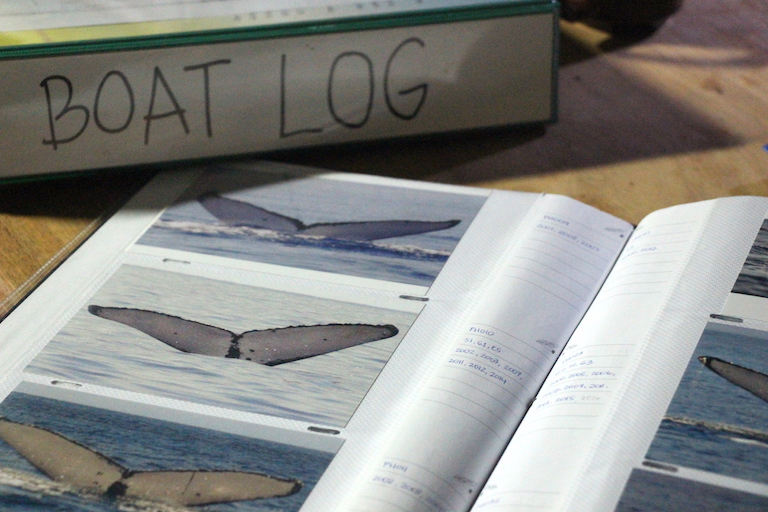- Baleen whales broadcast complex songs over long distances underwater, but maritime noise pollution from ships and other sources is squeezing their ability to communicate.
- With regulatory and technical solutions to ocean noise slow to spread, some researchers are optimistic that whales themselves will be able to change their vocalizations to overcome the din.
- Meanwhile, the U.S. National Oceanic and Atmospheric Administration last week released a strategy to study and mitigate rising noise levels and their effect on marine life.
Crossbow in hand, Jo Marie Acebes strides the deck of the outrigger fishing boat she has refitted for tracking whales off the Philippines’ Babuyan Islands. She’s scanning for a target in the very same waters that Herman Melville extolled as the gateway to the Yankee whalers’ Pacific hunting grounds in Moby Dick.
On the deck, the sounds are as placid as the vista of flat, steely ocean stretching to the horizon. Nothing to be heard but the whistling wind and the slap of gentle waves against the hull.
But 20 meters down, where Acebes has suspended an underwater microphone, there’s an entirely different soundscape: a brisk a cappella fugue performed by two voices, a pair of humpback whales (Megaptera novaeangliae) that may be located dozens of miles from the boat and each other.
One humpback takes up the theme and the other follows a few seconds later with the exact same series of sounds: three ascending whoops, then two low moans. This series repeats for a quarter of an hour before the leviathans switch to a sequence of whines, purrs, and pips.
Humpback whale calls. Audio courtesy of Balyena
Humpbacks and other whales forage, breed, and migrate in small, far-flung pods in an underwater milieu where sound waves travel four times faster than in air and reach much farther than light rays. In the course of their 48-million-year evolution, whales have developed a sophisticated array of vocal signals and exquisitely attuned mechanisms to produce and receive sounds.
For instance, Acebes’s collaborator, humpback researcher Jim Darling with the Hawaiian non-profit Whale Trust Maui, has found that only male baleen whales sing, either while alone or during short interactions with other males. And that they sing in a unique posture: on their backs with their heads canted down lower than their tails, like lolling crooners in Barcaloungers. Neither he, nor Acebes, nor any other whale researchers have been able to establish with certainty why baleen whales sing — it may have something to do with mating, bonding, or navigation — but they all agree the long-distance calls are essential to whale life.
But now those calls are being interrupted by a daunting new competitor: man-made maritime noise-pollution. Loud bursts of sound from naval sonar and offshore oil drilling rigs can harm whales and even kill them. Recently, courts in California and Hawaii ruled that the U.S. Navy’s sonar testing violated the national Marine Mammal Protection Act and limited testing in certain waters off the two states. Exposure to these high-intensity pulses can stop whales from feeding, cause them to temporarily lose hearing and stray from their migration paths, and even fatally injure their lungs and digestive systems.

Recently, scientists have turned their attention to long-term chronic noise, such as that produced by commercial container ship engines that ply booming trade ports. The data on the rise in long-term ocean noise levels is patchy. The U.S. National Oceanic and Atmospheric Administration (NOAA) reports a total increase of 10 decibels in ambient noise in Southern California waters between the 1960s and 2000s — an order of magnitude increase.
The whine of ship propellers and engines overlaps with the frequencies of baleen whale songs and calls. As a result, whale signals that once could carry for thousands of kilometers now get cut off much closer in, according to Cornell University researchers.
During a press call announcing the release of NOAA’s National Ocean Noise Strategy Roadmap last week, Jason Gedamke, director of the agency’s Ocean Acoustics Program, lamented the “surprisingly limited data on longterm noise.” He said he hopes the research gap will be remedied in national waters by 12 underwater listening and recording stations that have begun measuring ambient noise over the past few years.
“We indisputably have introduced more noise in the last 100 years, an exceptionally short amount of time on an evolutionary scale,” Gedamke told Mongabay. “The ocean is not silent. It’s a dynamic acoustic environment. There’s sound occurring naturally from wind, waves, volcanic eruptions. While marine life has had time to adapt to these sounds, humans have been adding more noise to the ocean since the industrial age. And these animals have to cope with that.”
How much will this steadily swelling anthropogenic cacophony disrupt whales’ communication? How will that impact the various species’s survival prospects? How well can they adapt to this abrupt (in evolutionary time) and drastic change in their sonic environment?

Human solutions
The quick answer to all three questions is: we don’t know. Research to date has fixated on certain species or geographic locations, but left many gaps in our understanding of the overall effects of chronic noise on whales. For example, scientists have documented North Atlantic right whales (Eubalaena glacialis) raising their voices and secreting more stress hormones in response to noise in Canada’s Bay of Fundy. And various researchers have detailed the response of blue whales (Balaenoptera musculus) to noise in the Channel Islands off the coast of Santa Barbara, where the U.S.’s busiest shipping lane is located. Blues’ songs either went silent or were masked by ship noise for multiple hours of the day. But remote places like Acebes’s site in the Philippines or even other shipping lanes along the American coastline are much less studied. Now governments in Europe and North America are beginning to study the effects of chronic noise more comprehensively.
The new Ocean Noise Strategy Roadmap, which Gedamke is leading, lays out a long, deadline-less, unfunded list of goals the NOAA website says are intended to “guide the agency in more effectively and comprehensively managing ocean noise effects on marine life during the next decade.”
Among other research directions, the document calls for archiving and analyzing more ecosystem sound data to help the agency assess how activities that generate underwater sound might impact animals. The authors predict that NOAA will eventually put more effort into noise mitigation efforts, so many of the goals focus on honing the agency’s “ability to characterize soundscapes” to allow it to assess the effectiveness of its mitigation measures. Goals include better monitoring of acoustically sensitive species, such as beaked whales (family Ziphiidae) and harbor porpoises (Phocoena phocoena), and the habitats they frequent, supporting international initiatives to reduce ocean noise, and creating a geospatial registry of federally authorized noise production events.

There are some operational and technological fixes available to reduce ships’ sonic footprint. In Australia, SLR Consulting Australia offers underwater noise mitigation assessments to freight companies and port authorities. SLR executive Shane Elkin suggests ships slow down and operate outside of breeding grounds and periods. SLR also tells companies how to modify their ships’ propellers, hulls, and onboard machinery to be as quiet as possible.
“Shipping noise generally induces behavioral disturbance/changes, rather than injuries for marine mammals,” Elkin told Mongabay. “Therefore management mitigation measures are normally in place to minimize noise levels.”
However, uptake of fixes like the ones Elkin suggests is not mandatory and therefore not widespread. Australia, the U.S., and many other countries lack national-level shipping noise regulations and international regulatory remedies have been slow moving. On the NOAA press call, officials said that they are encouraging the “baby steps” ports in the Pacific Northwest are taking to put in underwater noise limits on ships that dock with them.
In 2008, the Germany-based NGO Okeanos Foundation for the Sea convened in Hamburg for an “International Workshop on Shipping Noise and Marine Mammals.” The assembled activists and academics agreed to attempt a three-decibel reduction in “unintentional” shipping noise by 2018 and a 10-decibel reduction by 2038. The conclusions from this meeting eventually spurred the International Maritime Organization to adopt guidelines for commercial ship noise reduction in 2014.
Yet the IMO guidelines are voluntary. And 90 percent of everything we use today travels by ship, and the total volume is sure to increase with the ongoing march of globalization. So experts don’t have much faith that the ocean will become appreciably quieter anytime soon without further action.
“We know how to conceptually translate cumulative noise into an ecological cost,” states a slide that Christopher Clark, a Cornell University bioacoustics researcher who has long studied right whales, presented to a congressional hearing in 2014. “Actually, it’s not about noise, whales and science. It’s about us. Social and political will.”

Cetacean solutions
Some researchers are holding out hope that whales on their own resources may be able to learn to live with our noise. While physical adaptations only unfold over vast stretches of geological time, behavioral adaptations can occur much faster. Such flexibility might offer the whales’ best shot at evolutionary salvation, Acebes, founder and principle investigator of the Philippine whale research institute Balyena, ventures to hope.
She points to several lines of evidence to support her optimism. Captive whales have shown an ability to lower the threshold of sounds they can hear, and wild whales move away from loud noises.
When American whaling ships roamed the sea, Taiwan was a major stop on their fishing trips. Today, there are no whales off the coast of Taiwan but there are whales to the north and south of the island, in southern Japan and the northern Philippines where Acebes works, respectively.
“They likely moved south from Taiwan to these remote islands,” Acebes told Mongabay, positing a theory she is still testing. If baleen whales can change their migratory behavior to avoid whalers, she and other researchers think they might also be able to change their vocal behavior to keep up with the rising tide of noise.

Research has shown that some whales have already done so.
“Whales can respond to changes in noise on both short and long time scales,” John Hildebrand, who researches marine mammals and sound at the University of California San Diego, told Mongabay. For example, humpback whales increase their call volume to overcome elevated noise levels, as from passing ships, similar to the way humans might talk more loudly in a crowded room.
Hildebrand’s own research has found that a change in vocal frequency can endure over the long term, on the scale of decades and generations. In a study of blue whale song recorded over a period of four decades (from 1960 to the 2000s), Hildebrand and two colleagues found that for seven of the 10 song types, blue whales today are calling at lower frequencies than the one they used in the 1960s. The reason for the shift remains unclear, but may have to do with rebounding blue whale populations in the post-whaling era, he and his team concluded.
In any case, Hildebrand maintains that whales will probably adapt to the noisier oceans. “Those animals that are less stressed by higher noise levels, or that can best adapt to the new noise will be selected for contribution to future generations,” Hildebrand explained in an email.
With the new threat of chronic commercial shipping noise crowding out lower sound frequencies at an ocean-basin-wide level, perhaps higher-pitched whales or those more able to vary their vocal range will be best placed to persist. Humpback whales, such as the ones Acebes studies, have the widest vocal range among baleen whales and they learn new songs every year. In the 1980s the discoverer of whalesong — Rockefeller University biologist Roger Payne — described the humpbacks’ repertoire as “a missing link in the continuum of sound display leading from simple stereotyped singing to the full complexity of human song.”

That continuum, according to Payne, runs from creatures like crickets (whose song is genetically hard-wired) through those like sparrows (who pick up their simple songs during a juvenile “learning window”) to such virtuosos as canaries or red-winged blackbirds (whose learning is life-long, with each song acquired as a whole and never forgotten). Then come the whales, with an improvisatory flair rivalled only by humans. Humpbacks learn continuously, morphing old songs into complex new ones and leaving the old tunes behind.
So baleen whales’ ability not just to sing but also to jam might be their best shot at evolutionary salvation. NOAA’s Ocean Noise Strategy Roadmap will encourage researchers to watch for how quickly those adaptions are taking place.
| Reporting for this story was supported by an Internews Environmental Journalism Network grant. |
